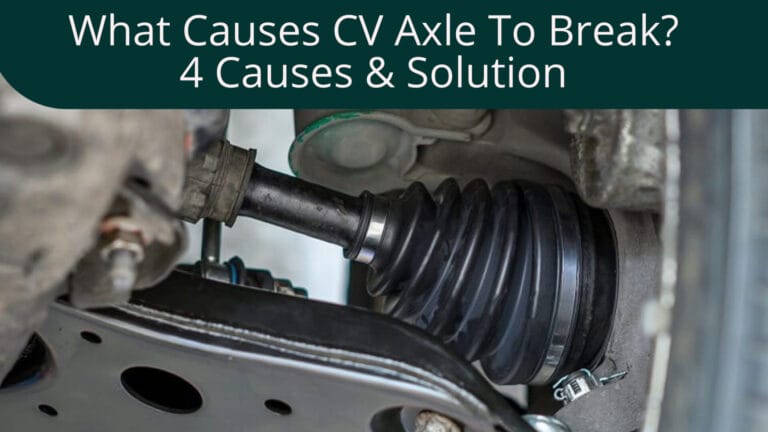Why Does My Car Wobble at Low Speeds? 7 Cluprits With Quick Fixes
Ever been on a cruise and thought, Why does my car wobble at low speeds? Or have you experienced swaying? You aren’t alone in this! The common culprit is unbalanced tires, because even a small weight differential on one side can throw off the entire ride. It’s like having a small stone inside your shoe—uncomfortable, huh?

If your car wobbles at speeds below 45 mph (72 km/h), it could mean more serious problems than just an imbalance. For example, a bent wheel, a separated tire (where the layers inside the tire start to separate), or problems with the suspension or handling could be signs of a problem.
Although there are several possible causes, it is sensible to start with tire balance. Stay with us as we explore this wobble mystery further to restore smoothness to your ride.
Wobble is Deriving from Your Steering Wheels or Not
A wobble in your steering wheel suggests that the problem is most likely in the front of the vehicle, either within the steering system or front wheels.
If, on the other hand, the steering wheel remains steady with no wobbling, the problem may still be with the front of the automobile. However, rather than a failure in the steering components, it is more likely due to suspension issues, misalignment, or the rear tires.

Why Does My Car Wobble at Low Speeds – 7 Culprits
Discover the cause of car wobbling and learn simple fixes to keep your journey smooth. Buckle up, and let’s get your wheels back in motion.

Unbalanced Tires and Wheels:
When tires and wheels are not balanced correctly, it can lead to uneven weight distribution. This imbalance can cause the steering wheel to shake and vibrate, especially when moving slowly.
This can happen if the tire loses some weight, like when a tread piece peels off or weights fall off the rim. It can also happen when a new tire is installed but is not properly balanced.
How To Fix
To detect imbalances, use a computerized balancer at a tire shop. To balance the tire, you will need a skilled mechanic’s help. Usually, wheels are balanced using specialist equipment; weights can be added or adjusted to create optimum balance.
Tire Damage or Tread Wear:
Too much damage or wear on the tires’ tread can make them wobble at low speeds. Tires with worn-out treads (less than 1.6mm) or uneven surfaces can become unstable, making driving shaky. Flat spots on the tires from sudden stops or sitting for a long time can also make the wheel wobble feel worse.
How To Fix
To get rid of a damaged tire problem, replace the bad tire with a new tire. Drive smoothly to remove flat areas gradually.
Misaligned tires and wheel alignment issues:
If the wheels aren’t lined up right, the car may pull to one side and wobble at low speeds. Tires that aren’t lined up correctly wear out unevenly, which makes the vehicle less stable and makes the car shake.
How To Fix
Camber, caster, and toe angles should be adjusted as needed. You should seek a professional wheel aligner to fix the wheel bearing, bent rim, etc., to avoid driving problems and make sure you have a straight and stable ride.
Damaged Suspension Components:
Struts, shocks, or bushings that are worn out or damaged can make the car less stable. These problems might show up as wobbling at lower speeds, which means that broken parts need to be checked out carefully.
How To Fix:
Replace worn-out suspension parts with new ones.
Problems with the brakes:
The car may wobble when driving at slow speeds if the brakes aren’t working right. For example, if you have a warped rotor or the brake pads wear erratically, you can face wobbling.
How To Fix:
Examine the braking fluid, pads, and brake rotor for signs of wear. Immediately replace them if there are any worn-out brake parts. If necessary, bleed the braking system to remove air.
Engine Problems:
If there are problems with the engine, like misfires or issues with the engine mounts, they can send vibrations to the vehicle, which makes it wobble at low speeds.
How To Fix
To find and fix possible problems, engines need to be serviced and scanned on a regular basis. Use an OBD-II scanner to diagnose engine problems; if they’re complex, see a trained mechanic.
Problem with the Exhaust System:
An exhaust system that is malfunctioning or not properly aligned can cause vibrations and shaking. Any broken or loose exhaust parts can cause the vehicle’s weight to be distributed inconsistently, making it less stable overall.
How to Fix:
Examine the exhaust system for loose or damaged parts, such as brackets or hangers. Tighten or replace any components that are causing the problem.
Common Symptoms of Car Wobbling
Usually, when we feel wobbling in the seat, floor, or pedals, we immediately name it car wobbling. But do you know that, aside from these symptoms, there are more that can also indicate you are facing car wobbling?
Detecting these symptoms early is crucial for rapid and effective resolution since wobbly cars can indicate various problems.
- Steering wheel vibration (40-60 mph).
- Vehicle wobbling felt in the seat, floor, or pedals.
- Strange noises like hitting, clicking, or grinding.
- Difficulty maintaining a straight line.
- Uneven wear on the inner or outer edges of tyre.
- Visible damage like cuts, bulges, or punctures on rear tire.
- Shaking steering wheel or handling changes.
- Low tire pressure warning light on the dashboard.
- Less stable ride, uneven tire wear, and tire noise.
- Excessive bouncing, swaying, or rocking.
- Soft or spongy brake pedal, slow acceleration, less power.
- Reduced stopping power and pulling to one side.
- Misfires, rough idling, or engine shutdown.
- Colored exhaust smoke or warning lights.
How to Determine the Real Problem Specifically?
To be sure where all the hell broke loose, you need to plan a thorough inspection of your car’s wheels, tires, suspension components, wheel alignment, brakes, drivetrain, engine mounts, etc.
Also, we suggest re-evaluating any recent incidents, like hitting a curb or a pothole, and ensuring you mention them when you take your car to the mechanic. Last but not least, have a professional inspection to be 100% sure.
Frequently Asked Questions
Is low-speed tremor a severe problem?
Yes, a low-speed tremor can be a serious issue because it may indicate underlying problems with the tires, suspension, or steering components, compromising both safety and vehicle performance.
Can low-speed wobbling be caused by wheel alignment issues?
Yes, wheel alignment faults can cause wobbling, especially while driving at low speeds. For stable and smooth driving, proper alignment is essential.
How can I keep my car from swaying at low speeds?
You can keep your car from swaying at low speeds through regular tire maintenance, wheel alignments, and timely suspension and steering component repairs.
Should I continue driving if my car wobbles at low speeds?
No, you shouldn’t continue driving if your car wobbles at low speed, as this may jeopardize your safety. Before continuing, have a skilled mechanic inspect the problem.
Closing Words
Now that you’ve figured out why your automobile wobbles and how to fix it, it’s time to play detective. Determine the source of the low-speed wobble and correct it. It’s okay if you’re not the handy type or if it requires a professional touch.
Get to the repair shop or speak with a professional as soon as possible. Don’t put it off any longer; keep that ride smooth and safe!





